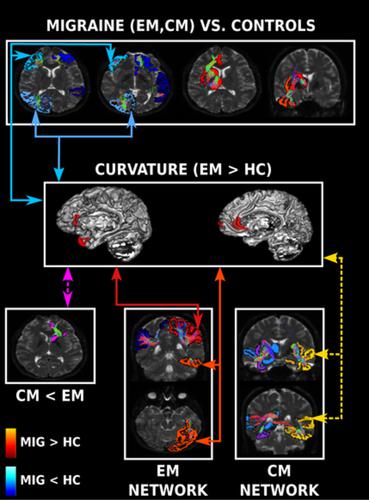当前位置:
X-MOL 学术
›
Hum. Brain Mapp.
›
论文详情
Our official English website, www.x-mol.net, welcomes your
feedback! (Note: you will need to create a separate account there.)
Multimodal fusion analysis of structural connectivity and gray matter morphology in migraine
Human Brain Mapping ( IF 3.5 ) Pub Date : 2020-12-08 , DOI: 10.1002/hbm.25267 Álvaro Planchuelo‐Gómez 1 , David García‐Azorín 2, 3 , Ángel L. Guerrero 2, 3, 4 , Santiago Aja‐Fernández 1 , Margarita Rodríguez 5 , Rodrigo Luis‐García 1
Human Brain Mapping ( IF 3.5 ) Pub Date : 2020-12-08 , DOI: 10.1002/hbm.25267 Álvaro Planchuelo‐Gómez 1 , David García‐Azorín 2, 3 , Ángel L. Guerrero 2, 3, 4 , Santiago Aja‐Fernández 1 , Margarita Rodríguez 5 , Rodrigo Luis‐García 1
Affiliation

|
No specific migraine biomarkers have been found in single‐modality MRI studies. We aimed at establishing biomarkers for episodic and chronic migraine using diverse MRI modalities. We employed canonical correlation analysis and joint independent component analysis to find structural connectivity abnormalities that are related to gray matter morphometric alterations. The number of streamlines (trajectories of estimated fiber‐tracts from tractography) was employed as structural connectivity measure, while cortical curvature, thickness, surface area, and volume were used as gray matter parameters. These parameters were compared between 56 chronic and 54 episodic migraine patients, and 50 healthy controls. Cortical curvature alterations were associated with abnormalities in the streamline count in episodic migraine patients compared to controls, with higher curvature values in the frontal and temporal poles being related to a higher streamline count. Lower streamline count was found in migraine compared to controls in connections between cortical regions within each of the four lobes. Higher streamline count was found in migraine in connections between subcortical regions, the insula, and the cingulate and orbitofrontal cortex, and between the insula and the temporal region. The connections between the caudate nucleus and the orbitofrontal cortex presented worse connectivity in chronic compared to episodic migraine. The hippocampus was involved in connections with higher and lower number of streamlines in chronic migraine. Strengthening of structural networks involving pain processing and subcortical regions coexists in migraine with weakening of cortical networks within each lobe. The multimodal analysis offers a new insight about the association between brain structure and connectivity.
中文翻译:

偏头痛的结构连通性和灰质形态的多峰融合分析
在单模态MRI研究中未发现特定的偏头痛生物标志物。我们旨在使用多种MRI方式建立发作性和慢性偏头痛的生物标志物。我们采用规范相关分析和联合独立分量分析来查找与灰质形态变化有关的结构连通性异常。流线的数量(从束线图估计的纤维束轨迹)被用作结构连通性度量,而皮质曲率,厚度,表面积和体积被用作灰质参数。在56名慢性和54名发作性偏头痛患者和50名健康对照中比较了这些参数。与对照组相比,发作性偏头痛患者的皮质曲率改变与流线计数异常有关,额和颞极的较高曲率值与较高的流线计数有关。与四个瓣中每个瓣的皮层区域之间的对照相比,偏头痛中的流线计数更低。在皮层下区域,岛状组织,扣带状和眶额皮质之间以及岛状组织与颞叶区域之间的连接中,偏头痛中发现了更高的流线计数。与发作性偏头痛相比,慢性时尾状核与眶额皮质之间的连接表现出较差的连通性。在慢性偏头痛中,海马参与了流线数量的上升和下降。偏头痛中涉及疼痛处理和皮质下区域的结构网络的增强与每个叶内皮质网络的减弱共存。
更新日期:2021-02-03
中文翻译:

偏头痛的结构连通性和灰质形态的多峰融合分析
在单模态MRI研究中未发现特定的偏头痛生物标志物。我们旨在使用多种MRI方式建立发作性和慢性偏头痛的生物标志物。我们采用规范相关分析和联合独立分量分析来查找与灰质形态变化有关的结构连通性异常。流线的数量(从束线图估计的纤维束轨迹)被用作结构连通性度量,而皮质曲率,厚度,表面积和体积被用作灰质参数。在56名慢性和54名发作性偏头痛患者和50名健康对照中比较了这些参数。与对照组相比,发作性偏头痛患者的皮质曲率改变与流线计数异常有关,额和颞极的较高曲率值与较高的流线计数有关。与四个瓣中每个瓣的皮层区域之间的对照相比,偏头痛中的流线计数更低。在皮层下区域,岛状组织,扣带状和眶额皮质之间以及岛状组织与颞叶区域之间的连接中,偏头痛中发现了更高的流线计数。与发作性偏头痛相比,慢性时尾状核与眶额皮质之间的连接表现出较差的连通性。在慢性偏头痛中,海马参与了流线数量的上升和下降。偏头痛中涉及疼痛处理和皮质下区域的结构网络的增强与每个叶内皮质网络的减弱共存。











































 京公网安备 11010802027423号
京公网安备 11010802027423号